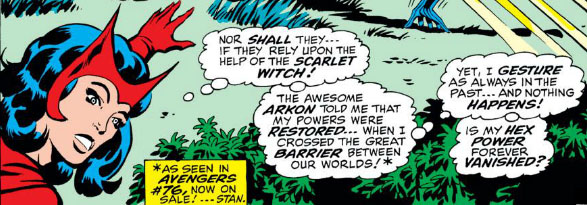In the beginning of her career, the Scarlet Witch, despite her abilities:
...wasn't exactly an action figure.
That wasn't for the lack of a pretty cool super-power. Her mysterious "hex power" was well before the Black Cat came on the scene, and was a fascinating complement to her brother Quicksilver's super-speed. For while opponents were focusing on Quicksilver's blistering attack, Wanda would generally sneak up under their radar and cause the enemy to screw up their attack in some way--for instance, they'd trip, or have a heavy apparatus fall on them.
She was an elegant character, to be sure. To summon her hex power, she had to merely gesture in order to cause things to crash down or someone's weapon to short-circuit. Which meant that, in order to convey to the reader that something exciting was happening, you had to rely on the narrative to get it across, rather than any sort of dynamic artwork. Otherwise, a pointing character isn't exactly going to stimulate excitement in a story:
And adding sound effects to the pointing just made for loud gesturing:
So when you're trying to dramatize gesturing, this is probably as dramatic as Wanda could get:
At some point, writer Roy Thomas apparently thought it was time for a change. After returning from her first leave of absence from the Avengers, we saw that Wanda had changed certain aspects of her costume--notably, her face mask, which originally had "framed" her face, was now more of a pinned hair piece. She basically went from this:
to this:
As for her hex power, even though Thomas had amped it up a bit since she'd left to restore her power in her homeland, the narrative could only convey through words how it had increased. With Wanda still invoking her power through gesturing, there was no way to demonstrate it to its fullest effect visually. And as an Avenger, now competing for story space with the likes of Hercules and Goliath, she needed to be on more equal footing with her teammates. Quicksilver and the Scarlet Witch were already coming across as fifth wheels, now that they no longer comprised one-half of the Avengers--so the next time she would return to the team after an absence (this time due to Magneto's machinations), the pair had to be more vibrant, more visually exciting.
Yet, before that story would take place, Thomas already looked to be experimenting with different ways to display Wanda's power. Instead of gesturing, why not a more forceful "firing" posture? In two different stories, artists Don Heck and John Buscema each gave brief but excellent demonstrations of how the new pose might come across:
A big improvement. But it presented a problem. If Wanda were to switch to fighting in this way, how could it be explained why she no longer simply gestured, when she'd been doing that since day one? This is where it gets a little weird. I might have thought of something as simple as the new posture being needed to handle an increase in power. But Thomas chose a different route. After that debacle with Magneto where she'd been injured by a gunshot wound, Wanda found that she had lost her power. She was to recover it later after a cross-dimensional journey--but the first time she attempted to use it again was in battle. A fine time to realize you're having problems with your ability to fight:
I don't know--if you'd just recovered your hex power after a debilitating injury, you'd probably want to test it before going into a major battle with the Hulk, wouldn't you? Say, by knocking over a vase or something? And wouldn't your teammates want to see a little demo before taking you out on a mission?
At any rate, Wanda is forced to improvise. And she stumbles on a way to call forth her power:
So here's the curious thing. Thomas puts a twist on Wanda's power by having her casting hex "spheres" with it--yet all but removes her control over her power's effect, while at the same time limiting her stamina in using it. Just what you'd want in an Avenger, isn't it? A team member whose power is both uncontrollable and unpredictable, and which could injure a fellow Avenger as much as an opponent--and who also can't use it more than once or twice without exhausting herself.
But, hey, at least she looks cooler doing it:
In addition, Thomas got a super-powered deus ex machina with the change--a way of inexplicably resolving a situation or introducing a plot twist without having to grope for an explanation. Let's just use a hex sphere. And Wanda has a whole cadre of Avengers around her, so she doesn't have to actively take the stage and battle with her abilities--just use her power at the right time. Only now, she looks the part.
But though Thomas avoided explaining Wanda's different battle stance, the elephant in the room was now why Wanda, despite the chaotic power level of her spheres, was now hampered and rendered near-useless by her own power. It was a factor that wouldn't be fully dealt with until Agatha Harkness entered her life--and, later, Chthon, who gave a more detailed explanation of Wanda's fluctuating power levels. A chapter in Wanda's life best left for another time.















2 comments:
Don Heck isn't everyone's favorite, but I kinda enjoy his simple style. And while Neal Adams took things to another level, I also dug Sal Buscema's work in The Avengers "Kree-Skrull War", particularly in the scene where the Vision falls for Wanda. Hexed indeed!
Buscema indeed did some exceptional art in those early Avengers issues before Adams and his brother took over art chores for the war itself. I'm going to be touching on that a bit in a later post. :)
Post a Comment